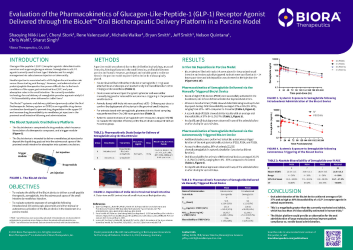Evaluation of the pharmacokinetics of glucagon-like-peptide-1 (GLP-1) receptor agonist delivered through the BioJet™ oral biotherapeutic delivery platform in a porcine model: an update
This preclinical study evaluated the bioavailability of semaglutide following both manual and autonomous needleless delivery to the small intestine.
The BioJet™ systemic oral delivery platform is an ingestible drug-device combination developed to prevent drug degradation in the upper gastrointestinal tract and increase drug bioavailability via needleless jet injection in the proximal small intestine following oral administration.
Glucagon-like-peptide-1 (GLP-1) receptor agonists stimulate insulin secretion and suppress glucagon release. Semaglutide is a GLP-1 agonist currently used to treat type 2 diabetes and for weight management via subcutaneous injection or taken orally. Needle injection is associated with a 42% higher discontinuation rate versus those starting oral therapy.1 However, oral administration of protein/peptide therapeutics has proven difficult due to the harsh conditions of the upper gastrointestinal tract and poor absorption rates in the small intestine. The currently available technology for oral delivery of semaglutide provides approximately 0.4 – 1% bioavailability when delivered in tablet form.2
In this study, we evaluated the ability of the BioJet device to deliver a small-peptide therapeutic via needleless injection into the submucosal space of the small intestine in a swine model by measuring systemic exposure to semaglutide after activation of the device. BioJet devices filled with ~1mg semaglutide were either manually or autonomously triggered in the proximal small intestine.
What did we find?
96% of animals (22/23) receiving autonomous delivery showed semaglutide in systemic circulation at clinically relevant levels for up to ten days following administration.3
Autonomous delivery demonstrated an average bioavailability of 20.5% ± 15.3% (N=22, CV: 74.6%) compared to IV control.3
Oral administration of the BioJet device achieved averages of 20-37% and as high as 60% bioavailability of a GLP-1 receptor agonist in animal experiments.3 This is a magnitude greater than the currently marketed oral tablet, which has less than 1% bioavailability estimated in human trials.2
Short oral presentation at the 59th Annual Meeting of the European Association for the Study of Diabetes, October 2-6, 2023, Hamburg, Germany.
Poster presented at the 59th Annual Meeting of the European Association for the Study of Diabetes, October 2-6, 2023, Hamburg, Germany.
Related Publications
REFERENCES
- Spain CV, Wright JJ, Hahn RM, Wivel A, Martin AA. Self-reported Barriers to Adherence and Persistence to Treatment With Injectable Medications for Type 2 Diabetes. Clin Ther. 2016;38(7):1653-1664.e1. doi:10.1016/j.clinthera.2016.05.009
- Novo Nordisk A/S. Rybelsus (oral semaglutide) [package insert]. U.S. Food and Drug Administration website.
https://www.accessdata.fda.gov/drugsatfda_docs/label/2021/213051s006lbl.pdf. Revised January 2023. Accessed May 31, 2023. - Lee SN, Stork C, Valenzuela R, et al. Evaluation of the pharmacokinetics of glucagon-like-peptide-1 (GLP-1) receptor agonist delivered through the BioJet™ oral biotherapeutic delivery platform in a porcine model. Poster presented at: 59th Annual Meeting of the European Association for the Study of Diabetes, October 2-6, 2023, Hamburg, Germany.

